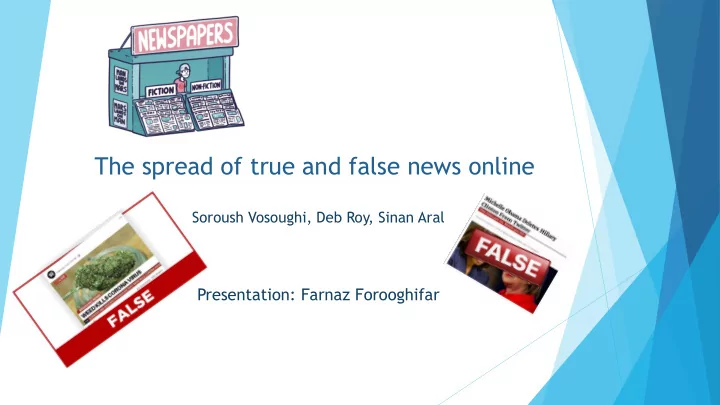

The spread of true and false news online Soroush Vosoughi, Deb Roy, Sinan Aral Presentation: Farnaz Forooghifar
Problem Questions How do truth and falsity diffuse differently? What factors of human judgment explain these differences? Objective classification of twitter news as true or false ( NOT fake news) and analysis of their diffusion
Definitions News : Any story or claim with an assertion in it, whether it is shared or not Rumor : The social phenomena of a news story or claim spreading or diffusing through the Twitter network. Rumor’s diffusion: One or more instances of a rumor spreading pattern that exhibit an unbroken retweet chain with a common, singular origin. # cascades: The number of times the story or claim was independently tweeted by a user ( not retweeted ).
Features Feature name Feature definition Cascade’s depth The number of a retweet by a new unique user from the origin tweet over time Cascade’s size The number of users involved in the cascade over time Maximum breadth The maximum number of users involved in the cascade at any depth structural virality A measure that interpolates between content spread through a single, large broadcast and that which spreads through multiple generations, with any one individual directly responsible for only a fraction of the total spread Retweet of a rumor increases all these features
Dataset Dataset Stories from 2006 to 2017 (English) 126000 stories By 3 million people More than 4.5 million times Labeling Information from six independent fact-checking organizations(95%-98% agreement)
Cascades B : false rumors: 1 and 1000 cascades, true rumors: more than 1000 cascades C : Peaks at the end of both 2013 and 2015 and again at the end of 2016, corresponding to the last U.S. presidential election E : Increases in the total number of false political rumors during the 2012 and 2016 U.S. presidential elections
Features A :Significantly greater fraction of false cascades than true cascades exceeded a depth of 10 B :Whereas the truth rarely diffused to more than 1000 people, the top 1% of false-news cascades routinely diffused to between 1000 and 100,000 people C :many more people retweeted falsehood than they did the truth F: It took the truth about six times as long as falsehood to reach 1500 people H:Falsehood diffused significantly more broadly
Political rumors vs others Political rumors diffuse more broadly and at greater depth
Novelty randomly selected ~5000 users who propagated true and false rumors and extracted a random sample of ~25,000 tweets that they were exposed to in the 60 days prior to their decision to retweet a rumor. C, E : false rumors were significantly more novel than the truth across all novelty metrics, displaying significantly higher information uniqueness
Emotional reactions categorized the emotion using National Research Council Canada (NRC), which provides a comprehensive list of ~140,000 English words and their associations with eight emotions — anger, fear, anticipation, trust, surprise, sadness, joy, and disgust D, F: We found that false rumors inspired replies expressing greater surprise , corroborating the novelty hypothesis, and greater disgust , whereas the truth inspired replies that expressed greater sadness, anticipation, joy and trust
Robustness of results The variance of and error terms associated with cascades corresponding to the same rumor will be correlated . A selection bias may arise from the restriction of our sample to tweets fact checked by the six organizations Requirement of more direct interaction with users through interviews, surveys, lab experiments, and even neuroimaging
Conclusion Falsehood diffused significantly farther, faster, deeper, and more broadly than the truth in all categories of information. false political news traveled more broadly at greater depths fewer followers, followed fewer people, less active on Twitter, verified less often, and had been on Twitter for less time Novelty attracts human attention, contributes to productive decision-making, and encourages information sharing Whereas false stories inspired fear, disgust, and surprise in replies, true stories inspired anticipation, sadness, joy, and trust .
Recommend
More recommend